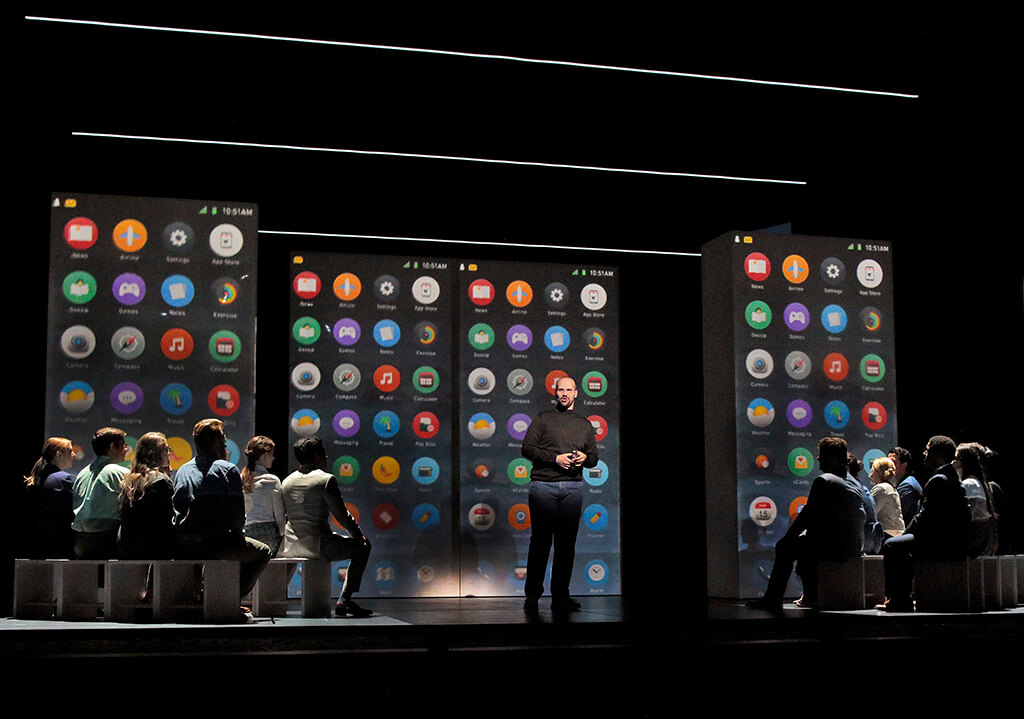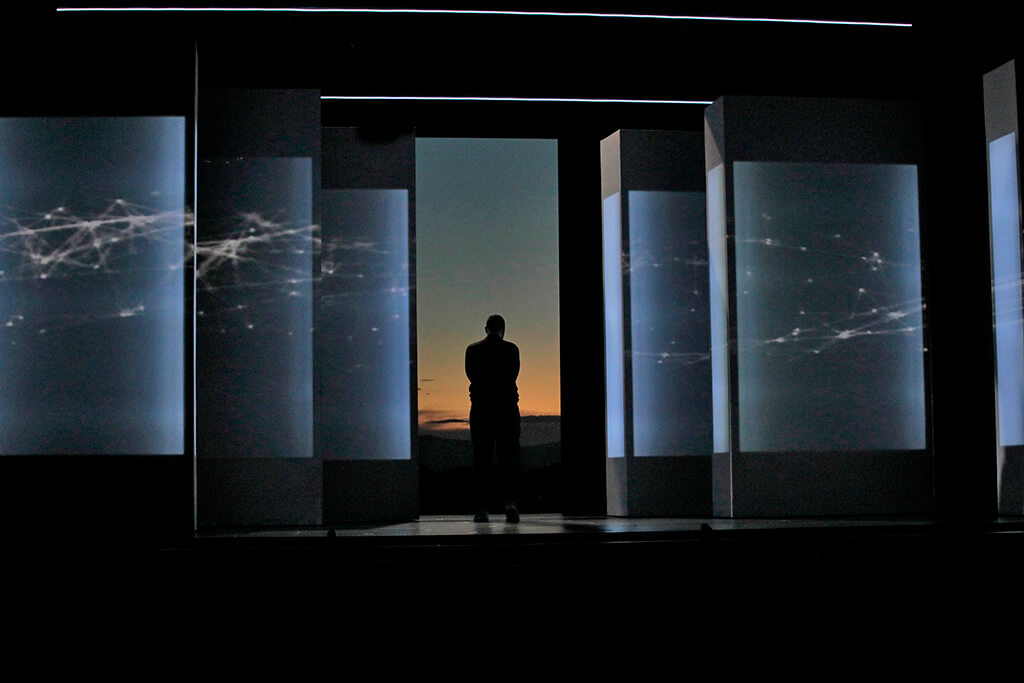
SANTA FE, NM — A cult celebrity for a subject. A trendy composer with crossover cred. Tons of advance publicity. Contemporary special effects. What could possibly go right?
As it happened, The (R)evolution of Steve Jobs scored an authentic if moderate success Saturday night at the Santa Fe Opera. The pioneer at the centre of the drama (libretto by Mark Campbell) was a figure of real interest and the music by Mason Bates faithfully reflected the alternating triumphs and misfortunes of his story.
And while set designer Victoria “Vita” Tzykun presumably had the latest techniques at her disposal, the projections conveyed a minimal grace of which Apple fans—or even those with no brand allegiance—could approve.
Remarkably, the modular units that served as screens for the projections (as realised by a company called 59 Productions) were piloted from within by human beings moving them choreographically around the stage. “Simplicity,” a concept much discussed by Jobs and his Buddhist preceptor, was in many ways the guiding principle of this production, directed by Kevin Newberry.
Nor did simplicity ever slip into stupidity. Bates has a DJ past and is probably equated in many minds more with pulsing electronics than music-making in the classical sense. Indeed, the composer was stationed in the pit for the premiere, controlling what conductor Michael Christie, in a preliminary talk to a group of critics, described as “very sophisticated music-generation programs.” I shuddered at the news.
Yet the ensemble of 50 musicians produced what sounded much more like an orchestral undertaking with electronic enhancement than the reverse. A sequence in which our hero drops acid with his first girlfriend, Chrisann, creates a pretext for a fanciful array of audio hallucinations (clarinet, oboe) in the context of a love duet with traces of the matchlessly simple opening Prelude of Book 1 of Bach’s Well-Tempered Clavier.
Not that dissonance is absent. The gusto of the famous 2007 launch of the iPhone in San Francisco (Campbell wisely avoids explicit product names in favour of such universalizing euphemisms as “the one device”) concludes with a downward electronic glissando as Jobs buckles over with exhaustion and pain. Thereafter the billionaire’s mortality becomes a central motif of the opera.
Sounds are dark also when Apple co-founder Steve Wozniak severs ties with the company, in part because Jobs has become too much a captain of industry but also because of his ruthless treatment of an individual employee. The personal imperfections of the title character are made particularly apparent when Chrisann’s pregnancy test comes back positive and Jobs advises her coldly to “get rid of it.”
Despite these episodes, the often whimsical libretto drew chuckles and even bursts of laughter from the enthusiastic crowd. “An interface only a motherboard could love” is how style-conscious Jobs characterizes the prototype Wozniak has created in the family garage. It is not the only quotable quote.
Narrative does not move forward in a linear way but as a chronological zigzag of 18 scenes. Serving as bookends are a prologue and epilogue in which young Jobs in 1965 receives a workbench from his father as a birthday present.
Campbell has pointed out this back-and-forth style would have created confusion in a work longer than 90 minutes. It was probably also helpful that many members of the audience (which was a little less skewed to the demographic north than is usual in Santa Fe) knew the basics of the story. It says something about the popularity of Jobs as an American icon that there was a burst of Broadway-style “recognition applause” when the adult version of his character first appeared.
The sturdy baritone playing Jobs was Edward Parks, a fair lookalike from row Z. He was on stage almost continuously. Other major players were mezzo-soprano Sasha Cooke as his devoted but exasperated wife Laurene; bass Wei Wu as his droll spiritual advisor Kobun Chino Otogawa; and tenor Garrett Sorenson as Wozniak. All projected well and if none of their arias sounded on first hearing like stand-alone hits, neither were they unequal to the occasion. Christie kept rhythms clear and made sonorities shimmer while Newberry cultivated a natural style of acting. The chorus (prepared by Susanne Sheston) was used economically and to good effect.
The (R)evolution of Steve Jobs is not easy to position on the tragicomic bandwidth. Neither nice guy nor villain, the title character is certainly complex but falls short of the operatic demands of a tragic hero. Anyone attending this opera with Peter Grimes in mind will have to settle for something less harrowing. Yet the piece does not fail in its primary responsibility of telling a compelling story.

What is remarkable and even commendable is that it does so without blaring full-frontal electronics and digital video fireworks. This is not an “edgy” opera. I might be tempted to classify it an operetta with shadowy elements in through-composed form (albeit with ad libitum rhythm in certain recitatives).
The final minutes—stripped of electronics in the interest of evoking transcendence—find Jobs viewing his own memorial service, a tad critically, with his master, Otogawa, who predeceased him. It is a good guess that this notorious perfectionist would also have found fault with the opera.
Yet The (R)evolution of Steve Jobs does what it sets out to do. The opening-night reception was rapturous. I think we can confidently predict similar reactions wherever Apple products are sold.
For more REVIEWS, click HERE.
#LUDWIGVAN
- SCRUTINY | Moussa Concerto Sounds Strong In Toronto Symphony Orchestra Premiere, Paired With Playful Don Quixote - April 4, 2024
- SCRUTINY | Esprit Orchestra At Koerner Hall: Ligeti 2, Richter No Score - April 1, 2024
- SCRUTINY | Sibelius & New Cello Concerto By Detlev Glanert Offers A Mixed Bag From The TSO - March 28, 2024



